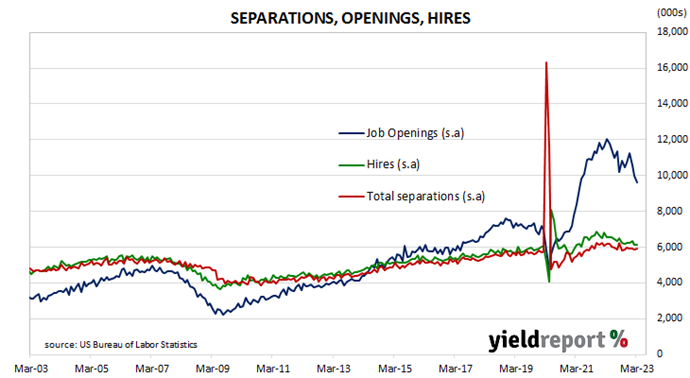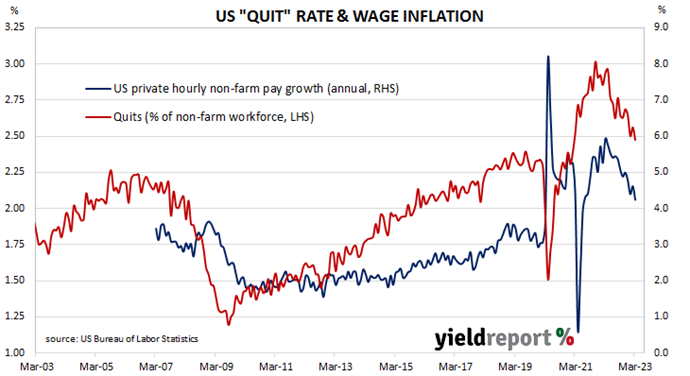Summary: US quit rate falls to 2.5% in March; NAB: diminishing prospects of switching to higher paying jobs; US Treasury yields down considerably ; expectations of lower rates firm; quits, openings down, separations up; ANZ: aggressive rate tightening starting to curb demand for workers.
The number of US employees who quit their jobs as a percentage of total employment increased slowly but steadily after the GFC. It peaked in March 2019 and then tracked sideways until virus containment measures were introduced in March 2020. The quit rate then plummeted as alternative employment opportunities rapidly dried up. Following the easing of US pandemic restrictions, it proceeded to recover back to its pre-pandemic rate in the third quarter of 2020 and trended higher through 2021 before easing through 2022 and early 2023.
Figures released as part of the latest Job Openings and Labor Turnover Survey (JOLTS) report show the quit rate decreased in March. 2.5% of the non-farm workforce left their jobs voluntarily, down from 2.6% in February. Quits in the month fell by 129,000 while an additional 236,000 people were employed in non-farm sectors.
NAB Head of Market Economics (Markets), Tapas Strickland said the numbers suggest “employees are seeing diminishing prospects of switching to higher paying jobs, although the quit rate remains above its 2.3% pre-pandemic average.”
US Treasury yields moved considerably lower on the day. By the close of business, 2-year and 10-year yields had both shed 16bps to 3.99% and 3.43% respectively while the 30-year yields finished 12bps lower at 3.71%.
In terms of US Fed policy, expectations of a higher federal funds rate in the short-term softened while expectations of rate cuts further out hardened. At the close of business, contracts implied the effective federal funds rate would average 5.02% in May, 19bps higher than the current spot rate, and then move up to an average of 5.04% in June. July futures contracts implied a 5.02% average effective federal funds rate while May 2024 contracts implied 3.73%, 110bps less than the current rate.
The fall in total quits was led by 178,000 fewer resignations in the “Accommodation and food services” sector while the “State and local government” sector experienced the largest gain, increasing by 20,000. Overall, the total number of quits for the month fell from February’s revised figure of 3.980 million to 3.851 million.
Total vacancies at the end of March decreased by 0.384 million, or 3.9%, from February’s revised figure of 9.974 million to 9.590 million. The fall was driven by a 144,000 drop in the “Transportation, warehousing and utilities” sector while the “Accommodation and food services” sector experienced the single largest increase, rising by 75,000. Overall, 9 out of 18 sectors experienced fewer job openings than in the previous month.
“Job openings are now at their lowest level in two years,” observed ANZ senior economist Adelaide Timbrell. “Demand for labour is continuing to soften, indicating the aggressive tightening in rates is starting to curb demand for workers.”
Total separations increased by 91,000, or 1.6%, from February’s revised figure of 5.841 million to 5.932 million. The rise was led by the “Construction” sector where there were 104,000 more separations than in February. Separations increased in 8 of the 18 sectors.

The “quit” rate time series produced by the JOLTS report is a leading indicator of US hourly pay. As wages account for around 55% of a product’s or service’s price in the US, wage inflation and overall inflation rates tend to be closely related. Former Federal Reserve chief and current Treasury Secretary Janet Yellen was known to pay close attention to it.


